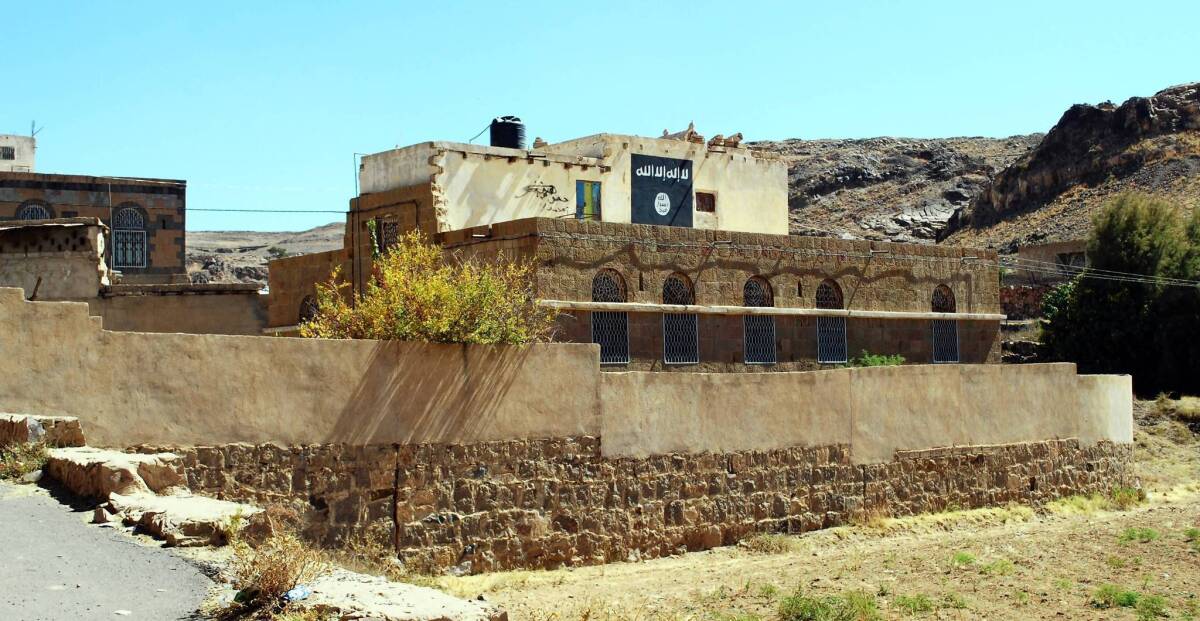U.S. drone strategy in Yemen is fraught with peril

- Share via
AL SARRAIN, Yemen — The U.S. drone flew over a cluster of mud houses on a ridge and, according to Yemeni officials, locked onto Adnan Qadhi, a mercurial man of many guises, including radical militant, peace mediator, preacher of violence and army general.
Villagers said Qadhi climbed out of his utility vehicle the night of Nov. 7 to make a cellphone call shortly before the missile struck. His photo — broad face peering from beneath a tilted red beret, stars on his epaulets — now hangs in a small grocery store in a land where farmers work narrow fields below the villas of politicians, tribal leaders and a former president that rise like fortresses on nearby hilltops.
Some here call him a martyr, others a fanatic. But the life and death of Qadhi, a senior officer in the 1st Armored Division who preached holy war in mosques and donned government-issued fatigues, epitomizes the political instability, tribal intrigue, crisscrossing allegiances and radical Islamist passions the United States must sort out when targeting militants in Yemen. At times, Washington risks being drawn into internal conflicts and becoming increasingly despised in the Arab world’s poorest nation.
Extremists here have a history of shifting tactics and circumstances. They were pressed into service by the government of former President Ali Abdullah Saleh when needed, then arrested and jailed when the political winds changed. Later they vanished from prisons by the scores, set loose across tribal lands. Yemeni security officials say that era is ending, and they’re stepping up military offensives to rout extremists — fighters from Libya, Somalia and other nations, and assassins on motorcycles intent on killing intelligence officials.
At the same time, the Obama administration has intensified airstrikes against the Yemeni group Al Qaeda in the Arabian Peninsula, which plotted in 2009 and 2010 to blow up American airliners. A 2011 drone attack killed Anwar Awlaki, an American-born Muslim preacher and militant recruiter. Weeks later, a U.S. airstrike killed Awlaki’s 16-year-old son, who tribesmen and relatives say had no links to terrorism.
The Long War Journal, a website that tracks U.S. drone activity, reports that since 2002, America has launched 57 airstrikes in Yemen, killing 299 militants and 82 civilians. The number of strikes has risen dramatically from four in 2010 to 40 so far this year.
“Why do these Americans come and interfere in Yemen?” said Radhwan Dahrooj, the grocer in Al Sarrain. “Why do they kill our people? If they have charges against someone why do they not arrest him and bring him to justice?”
Qadhi was sentenced to prison four years ago for plotting an attack on the U.S. Embassy in Sana, the capital, that killed at least 16 people, no Americans among them. With the help of clansmen and army officials, he was released shortly afterward and resumed his old life: militant and officer in the 1st Armored Division, led by Maj. Gen. Ali Mohsin Saleh Ahmar, a commander described in a 2005 U.S. diplomatic cable as “dealing with terrorists and extremists.”
When uprisings against President Saleh swept the country in 2011, the brigade mutinied and battled with competing tribes and security units for control of Sana.
What began as a peaceful revolution against Saleh tipped the nation — already fighting a rebellion in the north and a secessionist movement in the south — into deeper turmoil. Al Qaeda in the Arabian Peninsula and its affiliate Ansar al Sharia exploited the unrest, taking over territory in the south. That gave Qadhi an opportunity to expand his militant ambitions even as he slipped into another of his guises, currying favor with the government by mediating a truce between Yemeni officials and an Al Qaeda faction.
The U.S., which this year has given Yemen $337 million in military and security aid, would not confirm that a drone targeted Qadhi. Yemeni officials and villagers, who heard a plane circling that night, said a U.S. airstrike killed him not far from his home in Beit al Ahmar. Though Qadhi was an active Al Qaeda recruiter and often accused Washington in his sermons of wanting to keep Yemen divided and in chaos, it is not clear what specific danger he was seen as presenting to the United States.
Washington has no precise rules on the criteria for targeting militants with drone strikes. But President Obama has said that an extremist must present an imminent threat to the U.S. or its allies, as Yemen’s Al Qaeda branch is considered to do, and that arrest would be impossible.
A former senior U.S. intelligence official said Qadhi’s arrest for the 2008 embassy attack would not have been enough to put him on an assassination list. White House counter-terrorism advisor John Brennan has said that militants battling solely to overthrow the government in Sana are not targeted. But Qadhi’s 1st Armored Division was certainly a threat to the Yemeni government and the country’s stability.
Yemeni officials said the nation’s new president, Abdu Rabu Mansour Hadi, approved the strike against Qadhi after determining that an attempt to arrest him in his neighborhood could have led to more deaths. The officials said they were unaware of intelligence linking Qadhi to any active plot.
The danger in the drone program is the potential for U.S. intelligence and airstrikes to be manipulated by Yemenis seeking to weaken the competing clans and political factions. For example, Obama and his top generals felt misled in 2010 when Obama signed off on an airstrike against a senior militant that killed six people, including the deputy governor of Mareb province. The strike was based entirely on intelligence provided by the Yemenis, who had not told the U.S. that the governor would be there, a former senior U.S. official said.
Since Hadi took office in February, the cooperation and trust between the Yemeni government and the U.S. has vastly improved, U.S. and Yemeni officials say.
There are many potential drone targets. For decades, young men have left Yemen to become foot soldiers and bomb makers among the militants in Afghanistan, Algeria, Pakistan, Iraq and Libya. Some of them have come home.
One was Rashad Mohammed Saeed, who left at 15 and became a confidant of Osama bin Laden, fighting beside him in Afghanistan. He returned to Yemen around 2000 and in an interview said he had put aside his weapons to start the Renaissance Union Party, made up of former militants who run for parliament seats.
Like militants in other countries, he is struggling to reconcile a decades-long philosophy of violence and the more peaceful, and successful, political approach — at least in Tunisia and Egypt — of the protest movements that ignited the so-called Arab Spring. He worries about what many here describe as an incessant invisible buzz in the sky.
“We have entered politics. Do you think the U.S. will leave us alone to choose our own leaders and way of life?” Saeed asked. “Our party is close to Al Qaeda. We’re trying to get them to lay down their weapons. Yemen doesn’t need this violence now. We just need protection from drones. I may be a target myself.”
Hadi, who took over when Saleh stepped aside amid international pressure, has praised the drone strikes as a key to defeating terrorists. That has upset tribal scions who see their internal problems as being exploited by American interests.
“The drones have not killed the real Al Qaeda leaders, but they have increased the hatred toward America and are causing young men to join Al Qaeda to retaliate,” said Ahmed al Zurqua, an expert on Islamic militants. “President Hadi is distorting and violating Yemen’s sovereignty by cooperating with the Americans.”
The American attacks “are giving Al Qaeda immunity. The drones are killing innocent people,” said Sheik Abdrabbo Qadhi, a member of the parliament and no relation to Adnan Qadhi. “Al Qaeda is telling Yemeni that they are fighting these infidels and they’re telling our people that our state is helping the infidels.”
The sheik, pistol at his side, clicked his cellphone and held up a text message that Al Qaeda in the Arabian Peninsula had recently sent to lawmakers: “You members of the infidel parliament.... The swords of justice will behead all of you.”
“We want to uproot Al Qaeda,” he said, “but we have to do it ourselves.”
That has not happened, nor is it likely to.
The militants also face problems of their own making. In the spring of 2011, Al Qaeda and Ansar al Sharia exploited Yemen’s political tumult, temporarily taking over towns and villages in Abyan province in the south. The militants assassinated security chiefs and enforced a Taliban-like Islamic law. Al Qaeda provided temporary electricity and other services, but its medieval system of justice by amputation and whipping quickly lost it support among the tribes.
“Abyan was really the graveyard of Al Qaeda. People saw what the militants really were,” said Brig. Gen. Yahya Saleh, head of Central Security Forces. “Summary executions and chopping off of hands, this is not justice.”
Yet “Al Qaeda is not finished,” he said. “The war goes on. They have no central leadership. If they can flourish in a place, they will. Their ideology makes them strong. If one leader is killed, another one rises.”
ALSO:
Assad end may be near, but Syrian crises will continue
French president says Algeria suffered under ‘brutal’ colonialism
Tensions high as vote on proposed Egyptian constitution continues
Times staff writer Fleishman reported from Al Sarrain and Dilanian from Washington. Special correspondent Zaid al-Alayaa in Sana contributed to this report.
More to Read
Sign up for Essential California
The most important California stories and recommendations in your inbox every morning.
You may occasionally receive promotional content from the Los Angeles Times.














